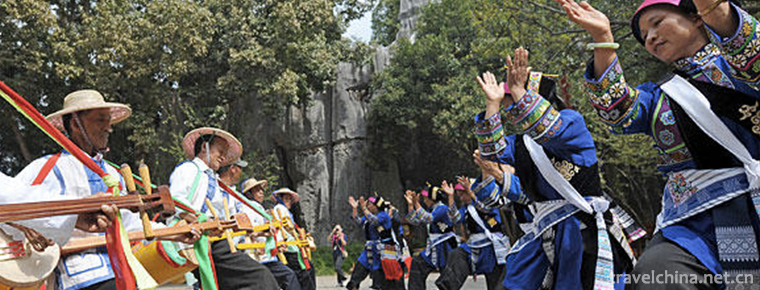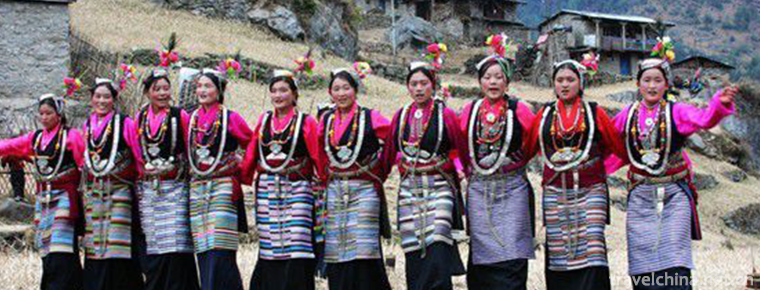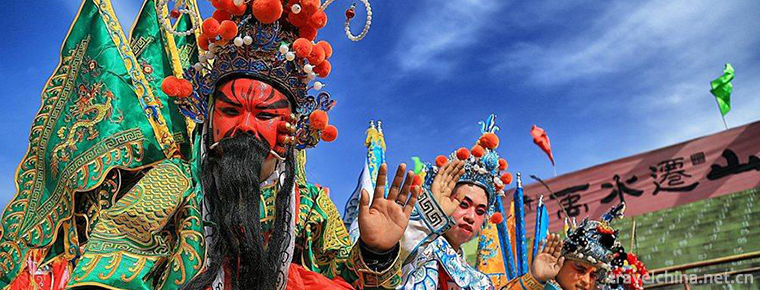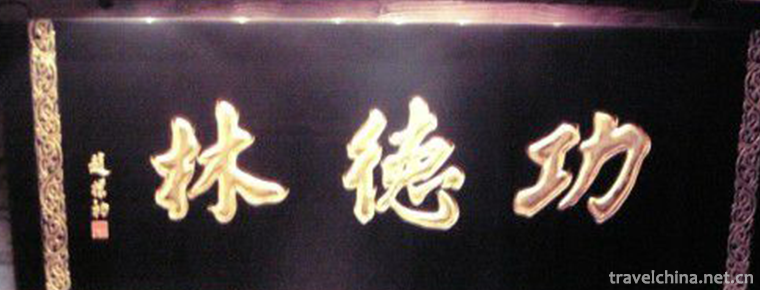Trichord Dance of Yi Nationality
Trichord Dance of Yi Nationality
Trichord dance of the Yi nationality is a folk dance handed down from generation to generation by the people of the Yi nationality. Different areas or different tribes of the Yi nationality have different names for them. The three-string dance that is popular in Sani Yi area is called "Sani Big Three Strings", and the three-string dance that is popular in Ashi Yi area is called "Ashi Dancing the Moon". It's a dance of leisure or joy. The three-string dance of the Yi nationality can be divided into two kinds: big three-string dance and small three-string dance.
On June 7, 2008, the "Yi Trichord Dance" jointly declared by Maile County and Shilin Yi Autonomous County in Yunnan Province was listed in the second batch of national intangible cultural heritage list with the approval of the State Council. Heritage serial number: 672 III-75.
historical origin
On June 14, 2008, the Trichord Dance of the Yi Nationality was one of the second batch of intangible cultural heritage lists published by the State Council. The people of Shilin dance big three-stringed dance to welcome guests. The ancient Yis big three-stringed dance in Shilin moved from Shilin to the whole country and the world in the 1980s.
Shilin Yi Autonomous County is located in the eastern part of Yunnan Province, southeast of Kunming City, belonging to Kunming City. It is more than 70 kilometers away from Kunming, the capital of the province. Stone Forest Scenic Spot, a world famous tourist attraction, is located in Shilin County. Shilin County was founded in the second year of the Yuan Feudal Period of the Western Han Dynasty (A.D. 109). It is called Tangao County. In the early Song Dynasty, Ludian was set up in Dali. From the Yuan Dynasty to the 13th year of the Yuan Dynasty (1276 AD), Lunan Prefecture was established. In the second year of the Republic of China (1913 AD), Lunan County was changed to Lunan County. The people's government of Lunan County was established in 1950. Lunan Yi Autonomous County was established in 1956, and was withdrawn in 1958 and classified as Yiliang County. Lunan Yi Autonomous County was restored in 1964 and renamed Shilin Yi Autonomous County in 1998. There is a wild and bold folk dance of the Yi nationality in Shilin County from generation to generation, i.e. the big three-stringed dance of the Yi nationality.
artistic characteristics
Dance Form
Sani dance has many forms and varieties. Big three strings, fork-jumping, knife-jumping, drum-jumping, bully-whip-jumping, lion-jumping, Tiger-jumping and hemp-weaving dancing, etc. The most famous and popular is the big three-stringed dance.
That is "Sani Dance Music". "Sani Dance Music" is the most favorite song and dance of the Yi people. They express their love for the big three-string dance with the words "people do not dance music, live in the world in vain, see three strings ringing, feel happy and itch at the foot".
Basic movements
The basic action of jumping big three strings is to take three steps and kick two feet, and constantly change the formation on this basis. So it is also called triple or jump music. Three-step music is divided into slow three-step music and fast three-step music. Slow three-step rhythm is slow, accompanied only by small three strings, suitable for middle-aged and elderly people to jump. The basic form of fast three-step music is that men play big three strings while women clap their hands and dance with big three strings and bamboo flute accompaniment. The whole dance rhythm is cheerful and emotional. It fully expresses the optimistic and cheerful feelings of Sani youth and loves life. It is deeply loved by the Yi people and appreciated by other nationalities.
Current situation of inheritance
The national songs and dances in Shilin area are famous both at home and abroad for their distinct national characteristics. The songs and dances of various branches of the Yi nationality belong to the typical folk songs and dances of the ethnic group, which have a wide range of popularity and livelihood. They originate from life and reflect life, and fully express the feelings of the Yi people. Because of this, it is also deeply loved by the people of other nationalities, and has had a wide impact at home and abroad.
Inheritance Significance
Trichord dance of the Yi nationality has been praised as the "living fossil" of ancient dance by the scholars concerned, which has a high value of understanding the origin and development of dance, has a positive effect on enhancing group consciousness and national unity, and has a good effect on creating a happy and warm atmosphere. In the 1960s, Sani Youth who went to Moscow to participate in the World Youth Festival performed the Yi Trichord Dance at the festival, which made the whole festival stir up. Over the past 20 years, many foreign tourists have visited the Stone Forest to appreciate the big three-string dance, which has gained a certain reputation in the world.


-
Lingwu Shuidonggou Tourist Area
Shuidonggou Ancient Human Culture Site is located in Shuidonggou Village, Linhe Town, Linwu City, Ningxia. It is 30 kilometers south of Lingwu City, 19 kilometers west of Yinchuan City.
Views: 141 Time 2018-12-12 -
La blun Temple
Labrang Temple is one of the six main monasteries of the Gelug Sect of Tibetan Buddhism. In 1982, Labrang Temple was listed as one of the key cultural relics protection units in China.
Views: 153 Time 2019-01-29 -
Eight treasures fragrant glutinous rice
Babao Xiangnuo is a famous dish in Zhejiang Province. It is cooked with glutinous rice as its main ingredient. It has the characteristics of soft glutinous rice and fragrant teeth..
Views: 226 Time 2019-03-26 -
Chentang Sherpa Singing and Dancing
Chen Tang Sherpa Song and Dance is a traditional folk song and dance in the Sherpa community of Tibet. Accompanied by "Zhanlie" (Six Strings) and "Biwang" (Huqin)..
Views: 119 Time 2019-04-16 -
Dong Pipa Song
Dong Pipa song is distributed in the southern dialect area of Dong nationality, which can be divided into lyric and narrative Pipa song. Its singing content almost covers Dong history.
Views: 117 Time 2019-04-28 -
Legend of windbreak
Fangfeng legend is a folk legend in Zhejiang Province. Between Fengshan and Yushan, Sanhe Township of Deqing, Huzhou, Zhejiang Province, the area of Xiazhu Lake is the largest wetland.
Views: 188 Time 2019-04-29 -
Folk fire Min Jian She Huo
Folk society fire is a kind of folk entertainment popular in China during the Spring Festival. It is widely spread in Shaanxi, Shanxi, Hebei, Henan, Liaoning and other provinces. On May 20, 2006, Folk.
Views: 154 Time 2019-06-05 -
Vegetarian production skills
Gongdelin vegetarian food originated in temples. During Tongzhi period of Qing Dynasty, Temple vegetarian food gradually entered society. In 1922, the disciples of Wikipedia, a Buddhist monk at Changj.
Views: 291 Time 2019-06-17 -
Yangge Dance
Yangge is a popular and representative folk dance genre in China (mainly in the northern region). There are different appellations and styles in different regions. In folk, there are two kinds of appe.
Views: 899 Time 2019-07-10 -
Wannan Medical College
Wannan Medical College is located in Wuhu, a famous historical city known as "the great port of the Yangtze River and the backbone of Anhui". It is close to the vast Yangtze River and gather.
Views: 138 Time 2019-11-19 -
Yibin local specialty
The production of bamboo spring, bamboo carving and bamboo weaving in Yibin city began in Yuan and Ming Dynasty, with excellent materials and local characteristics and life interests. Therefore, he became famous both at home and abroad and entered the court many times..
Views: 363 Time 2020-12-18











